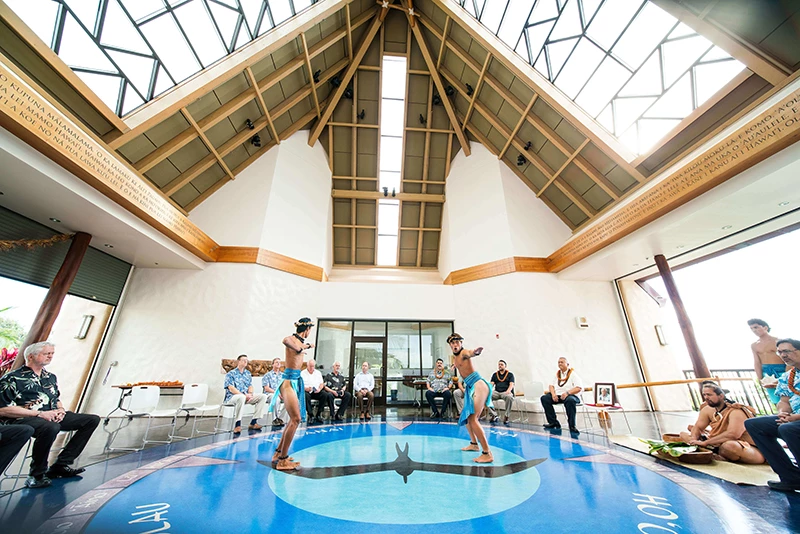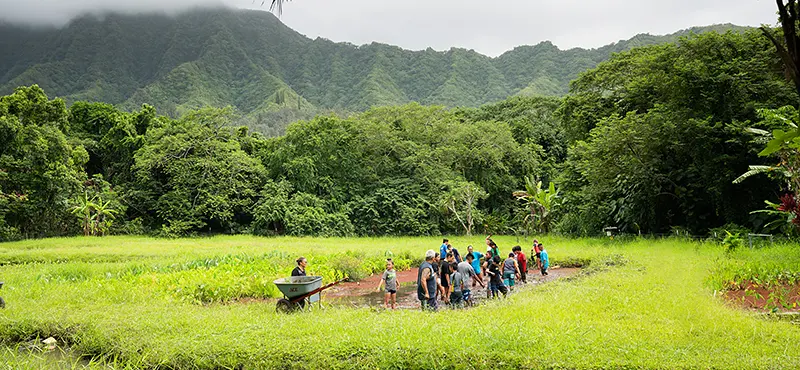On May Day in Hawaiʻi, the scent of blossoms fill the air and crowds gather to see mesmerizing hula performances. Children dance in colorful aloha wear, lei draped proudly around their shoulders. But behind the chromatic celebrations lies a deeper truth: every lei carries a story.
This year, as Kamehameha Schools campuses prepare for their Lā Lei celebrations, one story stands out. “The Queen’s Flowers,” a short film directed by Emmy-nominated filmmaker Ciara Lacy KSK’98 and executive produced by Auliʻi Cravalho KSK’18, has earned top honors at the Hawaiʻi International Film Festival and the New York International Children’s Film Festival. The silent animated tale reimagines a tender moment in Queen Liliʻuokalani’s final years, revealing how lei can symbolize love, loyalty and the will to endure.
Inspired by the true story of Emma Pollock and her time as a schoolgirl at St. Andrew’s Priory, the movie follows a young girl’s pursuit to make a crown flower lei for the visiting mōʻī. Set during Liliʻuokalani’s imprisonment at ʻIolani Palace after the illegal overthrow of the Hawaiian Kingdom, the film centers on her love for her garden as a sanctuary she meticulously tended.
“Everyone always kind of knew where the flowers were coming from,” Lacy said of the keiki who would sneak into the queen’s yard to gather flowers. “But the queen loved the girls and would often go over to watch them sing and she loved children and was famously known for carrying candy in her pocket to give to keiki.”
Lacy’s own upbringing in a lei-making family informed the emotional texture of the film. Her childhood memories of sewing green rose, pīkake and royal ‘ilima with her mom and aunties echo in the reverence and grace portrayed for the practice onscreen.
Though the film is non-verbal, every scene is layered with kaona, offering viewers the space to see themselves reflected while inviting broader audiences to connect emotionally, even if they don’t yet know the full history. In Hawaiian tradition, giving a lei is a gesture of love but in “The Queen’s Flowers,” the symbolism reaches deeper. Here, the lei is an offering of devotion to the sovereign queen and kingdom. At the film’s climax, the pua kalaunu given by a kaikamahine transforms into a crown — a vision of the queen at her throne flashing above a teary-eyed crowd — representing how storytelling can reclaim history through image and memory.
“Filmmaking is a form of visual sovereignty,” Lacy said. “It’s a way for us to understand ourselves and help our children to get a sense of history in a way they might not expect.”
From how the queen is offered flowers in cultural protocol to the delicate flutter of butterflies (captured, surprisingly, with the squeak of a cat toy in post-production), every frame honors the weight of tradition with the intent to be honest to the story and the people it represents.
“You’d be surprised that so much of filmmaking is not fancy,” Lacy said. “It’s just ‘ does this make sense? Are we being clear? Are we being true?’”
As students adorn themselves with lei this May Day, “The Queen’s Flowers” is a reminder that each strand means something for both the giver and the wearer. The adornments connect us to important places, people and history.
“Sovereignty starts with you,” Lacy said. “Do you feel like you have ownership in your everyday life? The colonizer’s choice is to take that from us. So every time we say ‘I have value,’ we take our power back.”
Lei Day is a celebration of Hawaiian culture and the continued breath of ea — sovereignty, strung together with loyalty, aloha and the unity of a people who remember who they are.
TAGS
alumni,
alumni success,
native hawaiian identity,
hawaiian history,
queen liliʻuokalani,
ʻōiwi leadership,
kapalama campus,
ks kapalama
CATEGORIES
Kaipuolono Article, Regions, Kona, O’ahu, Themes, Culture, Community, E Ola!, Kapalama Newsroom, Kapalama Home, KS Announcements, Newsroom, Kapalama, Community Education, Alumni, Kapalama, Oahu, KS Kaiāulu, Oiwi Leaders, Kapalama campus
Print with photos
Print text only










